Essential guide | Paid vs earned vs owned media Talkwalker
Paid vs earned vs owned media. Learn how to use them in your marketing strategy. Enhance online presence and brand authority.
June 8, 2020
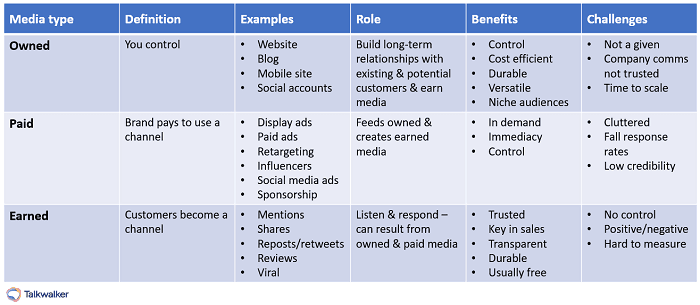
- Table of contents
- Definition of paid media
- Paid media benefits
- How is paid media measured?
- Paid Social - Paid media tool
- Problems with paid media
- Definition of earned media
- Benefits of earned media
- Problems with earned media
- Paid and earned media working together
- How is earned media measured?
- Definition of owned media
- Benefits of owned media
- Problems with owned media
- How is owned media measured?
- Definition of shared media
- Combining paid, earned, and owned media
- Examples of paid vs earned vs owned media in sync
- How to choose which media
- Using paid vs earned vs owned media in your marketing strategy
- Will paid, earned, owned media help SEO?
- Paid vs earned vs owned media SEO strategy
- Takeaway
- New feature - Paid Social
Show Me My Paid, Earned & Owned Channel PerformanceCheck out the latest addition to our analytics suite, so you can optimize your digital campaigns & have full visibility of your paid, owned & earned media.Marketing campaigns only work if your marketing content is seen by your audience - customers and prospects. Paid media, earned media, owned media are the three key ways for you to distribute your messaging.

Your PR strategy needs paid, earned, owned media to engage with your audience and increase trust.This post is going to give you the definition of paid vs earned vs owned media. The benefits to your brand, along with the potential drawbacks. I’ll also show you how they work with SEO. Plus, which media type will work best for your business…Teaser alert… all of them.Working with each successfully, requires a multitude of digital marketing skills…- Developing a content and SEO strategy
In case you need more details, I’ve linked to relevant content for each.I'm not going to lie, it's a long post. But, it's packed with information on how to run successful paid vs earned vs owned media strategies. The table of contents is anchor-linked, so you can zip around. Enjoy!
Table of contents
Definition of paid media
Media placement that costs…Paid media includes all the stuff you have to pay for - search, display ads, SEO and PPC campaigns, social ads, influencers, guest posts, sponsorships, boosted posts on LinkedIn or Facebook, Google Adwords, TV, radio, etc. You’re paying to use a channel to drive traffic to your owned media - website, blog, landing pages.Paid media requires planning and rigorous testing. It needs to be targeted and well-executed. As consumers, we’re not so easily swayed by brand promotions, hard-sell techniques, and clever marketing. We’re looking to build relationships with brands. Brands we trust and love. Save your money, if you’re planning to simply flood Twitter with irritating ads. Consumers will swat you away, like a fly.
Paid media benefits
Execute paid media well, and you’ll see an immediate ROI. You’ll quickly generate leads and increase traffic to your owned media. Once they’ve landed there, you can nurture them and convert leads into sales. Let’s check out more benefits and where you could be using paid media…
Control
It’s yours. You’ve paid for it.That means, you start and stop as you wish. If your ad on Twitter isn’t working, pause it. Work out why it’s not working. Cancel or restart. If you crack on with a LinkedIn ad to drive traffic and bring leads, and you reach your target ahead of schedule. Or, the quality of the leads is below parr - stop the ad. Don’t waste money on paid media that’s not working.
Targeting
Which platforms work best for paid media?A platform that can target ads and segment the audience, are the most effective. For instance, social media networks offer demographic information about followers, meaning that targeting messages is a cinch.
Display ads
Display ads are a cost-effective way of reaching your target audience, by identifying websites that your audience relates to. The Google Display Network reaches 90% of Internet users worldwide. Meaning, your ads could appear on over 2 million different websites, and more than 650,000 apps. If you'd like to read up on paid advertising, check out my Extensive Guide on SEO and PPC.
Paid search
I’m talking about SEO and SEM. Paid search will generate traffic from search results based on keywords and phrases. Marketers can target specific locations and languages.
Social media ads
Twitter, Facebook, Instagram, LinkedIn… paid social media advertising is the best way to increase your likes and reach, generate leads, boost engagement, and drive traffic to your site, especially globally. A paid campaign can be targeted towards a specific audience and location. Meaning you reach the right people in the right place. Social media stats last year showed that more than 92% of small businesses plan to increase their social media ad budgets. 58% of companies plan to increase spending on Facebook. 39% on YouTube and Instagram.Don’t forget to check out my Social Media Metrics that Matter, plus Dan’s Social Media Data Sources for Brand Monitoring.
How is paid media measured?
As with any reporting, you can’t measure until you’ve established your business objectives and goals.When you post paid ads on social media, you can use the inbuilt analytical tools to measure results. I warn you though, you’ll get more insightful data if you use a specialized social media analytics tool.Shout out for the boss...The Talkwalker Analytics platform has a number of tools and features to analyze the social data surrounding your media campaigns, and measure the results. You can mitigate brand reputational risk with instant and predictive alerting. The AI-powered sentiment analysis will determine the emotion behind brand mentions. There’s also image and video analytics.
Paid Social - Paid media tool
We’ve recently added a new feature - Paid Social - which integrates your owned, earned and paid media data into a real-time dashboard. You have visibility of all your campaigns. Reporting is centralized and automated. Your KPIs are streamlined. Combining all your media data makes it easier to optimize your performance and prove your ROI.
Full visibility of campaign performance
Having visibility of both organic and paid campaigns means you have the data at your fingertips, rather than waiting for various teams to submit their reports. You can track in real-time the performance of your campaigns, so if any are failing, you can improve.
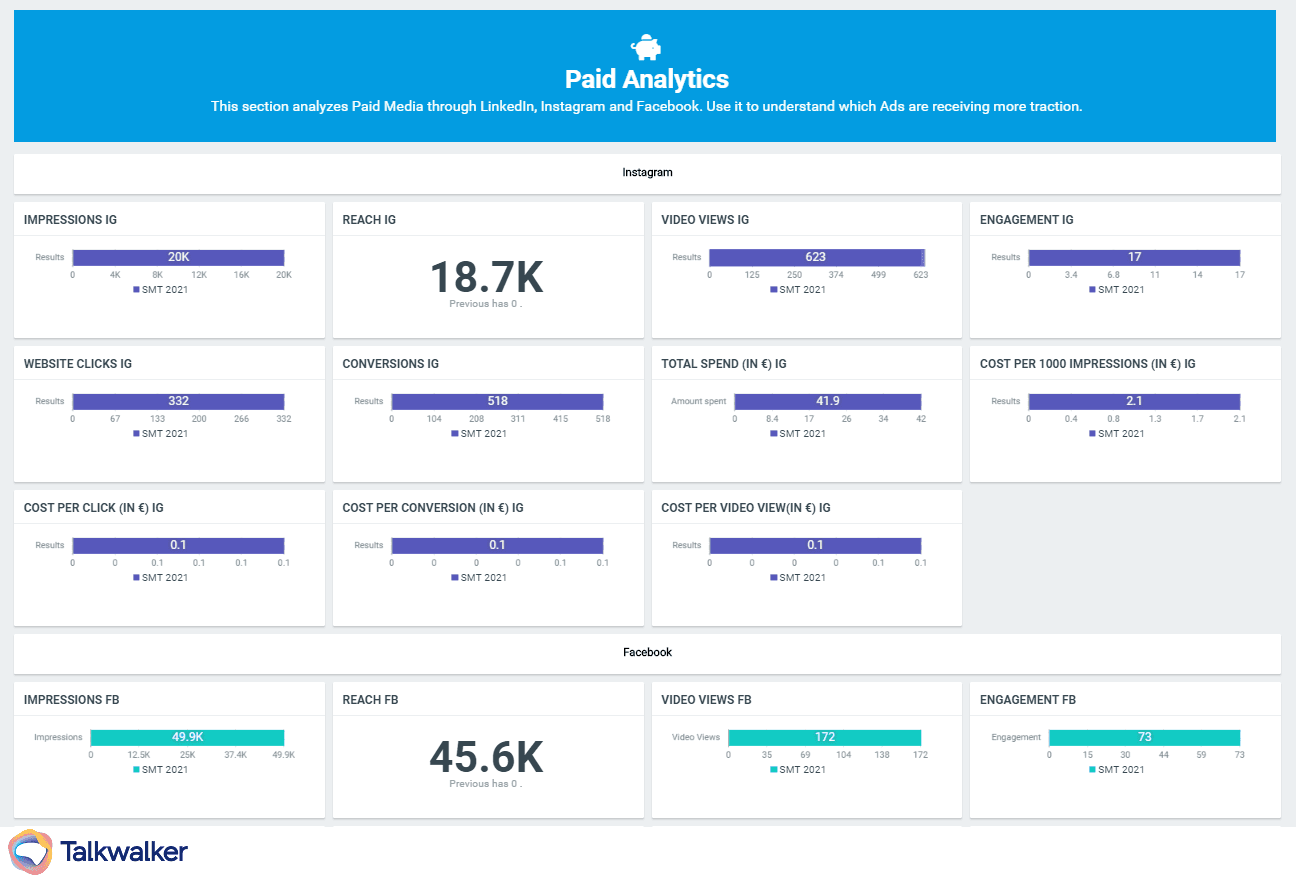
Paid Social gives you access to data so you can update content that's underperforming.
Find best organic content to create paid ads
To ensure you don’t waste any of your marketing budget, use Paid Social’s campaign dashboard to identify organic content that’s engaging, and repurpose to create paid ads for your social channels.

Access to you social campaign dashboard means you can quickly identify the most engaging messages & optimize your ad spend.
Faster, automated reporting
Say goodbye to Excel spreadsheets!Save time, with all your social data stored in one place, and automated reporting at the end of each social campaign.
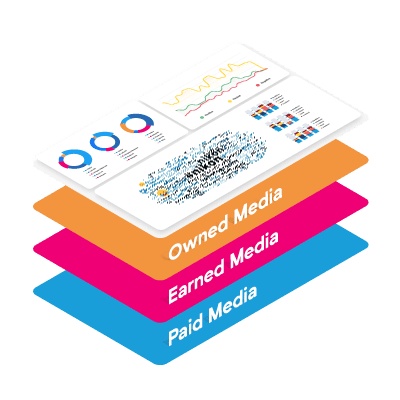
Consolidate owned, earned & paid media data for fast, accurate reporting.
Brand protection from negative comments on ads
Paid Social uses sentiment analysis - in 90+ languages - to identify negative comments. You’ll receive an alert, so you can stop the ad and manage the potential issue.
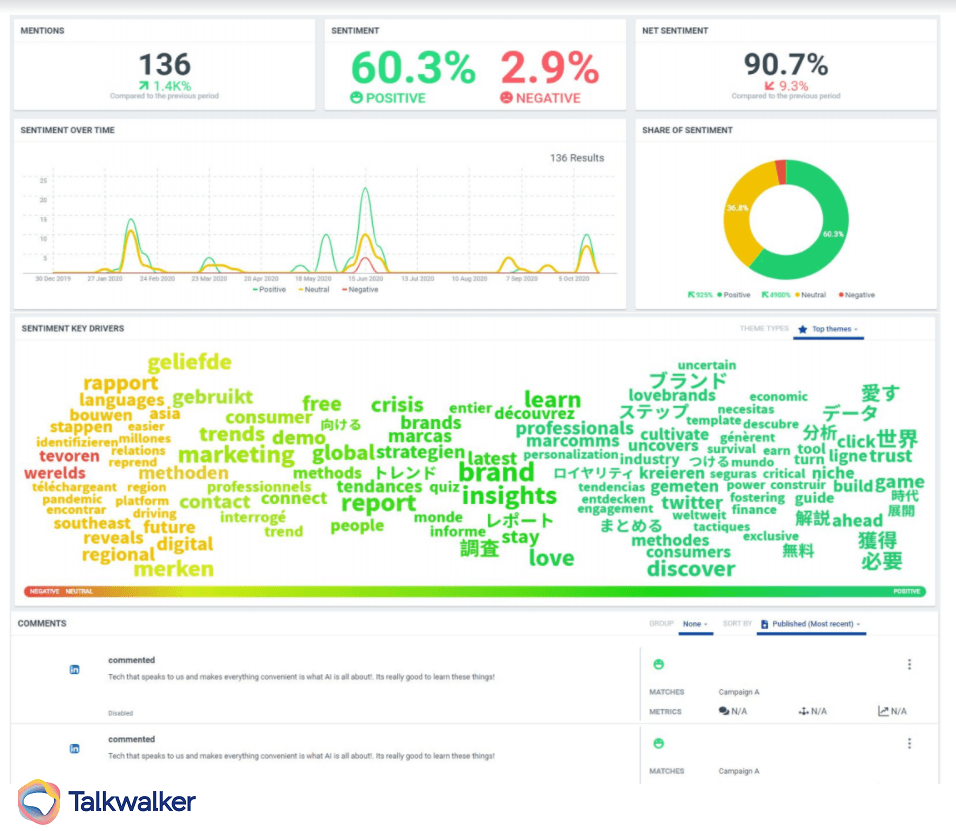
Find negative comments in your ads with sentiment-based alerts, so you can tackle issues quickly.The performance of your PPC ads - pay-per-click - can be measured with Google AdWords. Plus, Google Analytics will divide paid search and paid social, and display in different channels. This means you can track and analyze increases in traffic, leads, and opportunities.
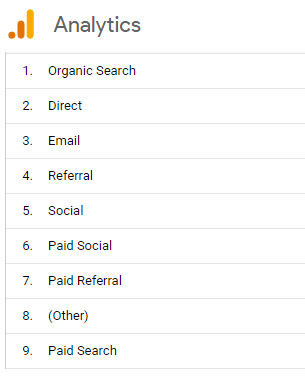
Google Analytics divides paid, earned, owned media sources.
Problems with paid media
I’ll highlight the problem, even though it’s a bit obvious. Once you stop paying, your content stops being shown to consumers. Told you it was obvs.
Definition of earned media
“90% of consumers say that user-generated content influences their buying decisions, outranking all other forms of marketing.”
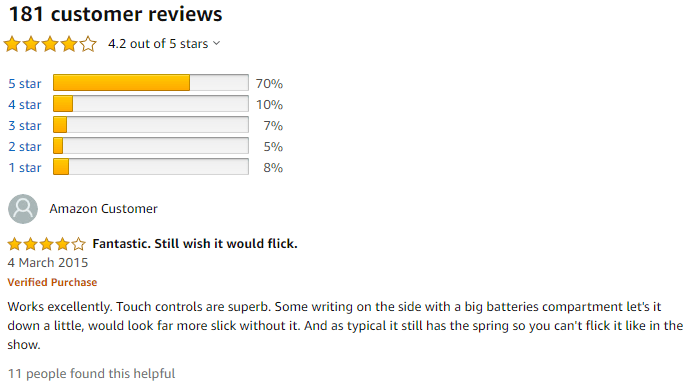
Amazon provides user-generated content - social proof - to enhance consumers purchasing experience.UGC is earned media - recommendations from friends, family, peers, colleagues.Earned media places consumers into your media channel. Earn enough interest from them, and they’ll want to share your messages with their followers. You provide valuable content to people => you earn media when they share it.You’re turning consumers into brand advocates and influencers. Similar to word of mouth marketing. It creates social proof - reviews, quotes, social media interaction, testimonials, user-generated content. UGC brings more engagement than any other form of marketing content. We trust it, because it comes from real people. We’ll happily purchase the products they recommend.One drawback is that you don’t have the control over earned media, that you have with paid media. You don’t know how, when, where, or if your content will be shared. You can’t stop people spoiling your content or sharing with a negative slant. Earned media rarely works alone, so be sure to include it in your marketing strategy with your owned and paid media.
Benefits of earned media
It’s free...When it works, it works big. If your content goes viral, you’ll drive brand awareness and increase content visibility. But, remember, you don’t have control. You can’t choose where it’s placed. You can’t stop people using it negatively. You can’t force people to use it positively. You can’t guarantee that the consumers seeing your message are potential customers. But…Despite the downside, there are benefits to including earned media in your marketing strategy…
Endorsement of your content by trusted online sources
Stronger level of communication with consumers on their preferred social media platforms
Increased exposure of your marketing content
Your content promoted in various media environments
Problems with earned media
I’ve already touched on some pain points with regard to earned media. To help you avoid them, I’ll go a little deeper..
No planning, no control
As marketers, we both fear and desire virality. You can’t force it to happen. You can’t plan it. But, you can be prepared. If a celebrity, royal, or influencer - unpaid, cos this is earned media - wears something from your fashion brand, be ready for the onslaught of orders. If something goes virally wrong, you must ensure your PR crisis management plan is tried, tested, and up to date. Remember #orangegate? __CONTENTFUL_EMBED_0__Whole Foods thought it would be a cracking idea to sell pre-peeled oranges.C’mon, who enjoys peeling oranges?Living in a world being suffocated by plastic, a Twitter user decided to highlight the obvious flaw in this brand campaign. It went viral, inviting ridicule and anger. Hat’s off to Whole Food, they did respond quickly and cleverly…"Definitely our mistake. These have been pulled. We hear you, and we will leave them in their natural packaging: the peel."__CONTENTFUL_EMBED_1__The brand exploited the unexpected virality and shared a new image, winning back the brand love.Check out our report - Brand Love Story | The World's Most Loved Brands - to see how Whole Foods and 49 other global brands win our love, through the good times and the bad.
Platform algorithms
If a social media platform changes its algorithm, it hits organizations that rely solely on earned media.When Facebook updated its algorithm to prioritize meaningful interactions from friends and family, brands took a big hit. We lost reach.We can’t predict this. We can’t stop it.
B2C beats B2B
According to research, B2B content is shared at a rate only 1/10th that of B2C content. Doesn’t matter how great your marketing content is, it won’t achieve the same reach as it would if it was B2C.You might think your latest product is the cat’s pajamas, but it’s never gonna top the photo of a cat wearing pajamas.Earned media has to be part of your marketing strategy, but if you’re B2B, you have to include paid media.
Paid and earned media working together
We understand the differences. Paid media brings control and targeting. While, earned media is more fluid. You have little control over placement and reactions, but you can get a big viral win.To work successfully, paid, earned, and owned media should all have a place in your marketing strategy…
Owned media - create engaging, relevant, customer-focused, educational, supporting content
Paid media - place your marketing content on targeted paid media platforms
Earned media - win consumers’ trust and loyalty to build a network of brand advocates
How is earned media measured?
Earned media and PR work hand in hand. Remember the benefits?
Builds brand awareness
Increases credibility
Builds trust and loyalty
Improves SEO
Increases leads, sales, ROI
Dan’s Metrics to Monitor to Define Success eBook reveals all the data that you should be monitoring, to prove that your earned media is earning. He’s also written a post - Is Earned Media Value (EMV) really valuable? - it highlights important metrics to measure...
Engagement
Engagement metrics will help you understand how valuable a piece of content is. For instance, if your content reaches a small, but engaged audience, it’s a winner. It’s more valuable. By measuring your engagement regularly, and comparing with your competitors, you’ll be able to identify how effective your earned media strategy is.

Use Talkwalker Analytics to track engagement over time.Dig deep into spikes to find the cause.
Sentiment
I’m talking positive and negative. A piece of content coming from a third-party - unpaid - influencer, guest blogger, press release, review - would be considered valuable, if positive. But, if it’s slamming your brand with the potential to damage sales, you need to factor it into your earned media measurement strategy.
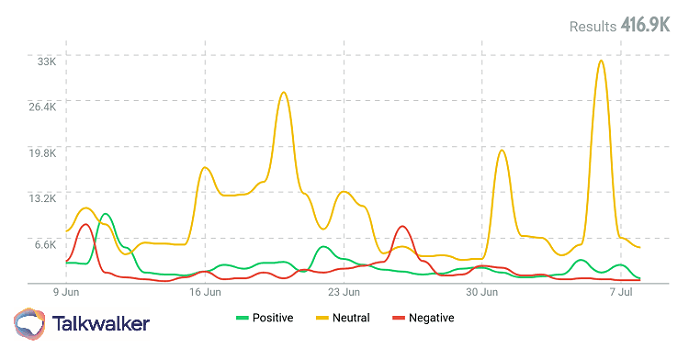
Talkwalker Analytics - monitor sentiment spikes to identify if something is driving positive earned media value or is damaging your brand.
Share of voice - SOV
SOV will show how many mentions your brand is driving, while comparing to the number your competitors receive. Yes, you may have been mentioned in a blog on a high authority website. But, your main competitor earned two other mentions. It’s important to perform competitor analysis, and determine their performance to understand whether your earned media value is adding value to your business, or falling off a cliff.
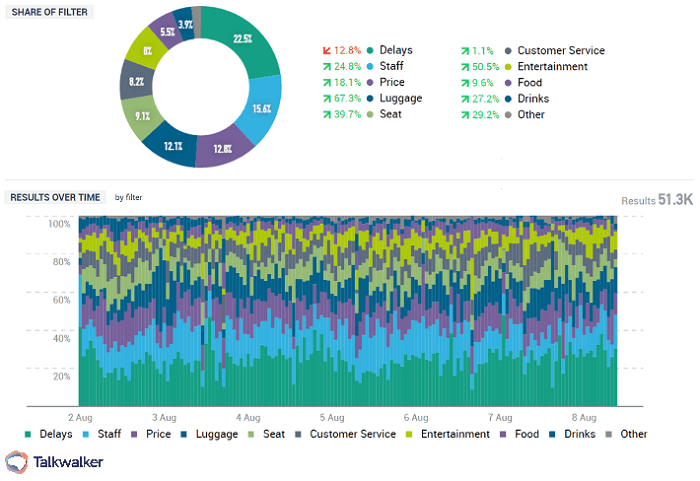
Talkwalker Analytics - share of voice identifies the proportion of discussion online about your brand.Share of discussion of complaints from airline customers on social media.Download my free Metrics to Monitor eBookProve your paid vs earned vs owned media strategy is working, download our free metrics eBook.
Definition of owned media
Owned media is everything that your brand owns...
Websites
Blog posts
Social media content
RSS feeds
Apps
Stores - off and online
Brochures - hard, soft
Press releases
Direct email campaigns
LinkedIn posts, Facebook updates, LinkedIn articles, LinkedIn company profile
Email newsletter - to contact lists you own
Whitepapers, eBooks, case studies, reports
Your paid and earned media should be designed to drive consumers to your owned media. Whether they convert, is down to the power of your owned media.It would be safe to assume that the majority of businesses have an online presence. Maintaining it, along with other owned media, is vital to a successful marketing strategy. You need a targeted content strategy, along with a strong social strategy, plus time spent ensuring consumers see it. Do it well, and you’ll build long-term relationships, while increasing your earned media.
Benefits of owned media
YOU’VE GOT CONTROL!You decide how you want it to look. You decide when you want to release or publish. Teeny weeny drawback is that once you’ve set it free, it’s vulnerable to negativity. Equip yourself with a tool like Talkwalker Alerts and some clever search terms, and you’ll receive early notification of potential problems.

Talkwalker Alerts - take back control of your media mentions with our free alerts tool.Distributing your owned media is free, but to get eyeballs on your content in search engines, it requires SEO. Remember, you’re trying to play Google and its ranking factors. Which remain hush-hush.Once you’re ranking on page one, your website traffic will increase as more people see your content. Manage your content well - keep it current, optimize - and the traffic will continue. And… it won’t cost you a dime.
Problems with owned media
If no one sees your owned media, it’s not going to work. Search engines - Google, Bing, etc. - are the primary platform for displaying your owned media.As I mentioned earlier, with the ranking factors hidden, it takes time and effort to achieve a high ranking in SERPs. Win this battle, and you’ll get more traffic, for free.Search engine algorithms - like social media - are updated regularly. This is to stop people playing the system, and ensure we all have a shot at the top spot.Page one on Monday. Page three on Friday.
How is owned media measured?
This is going to depend on what owned media you’re producing, and what you want it to do.If you’re publishing regular blog posts to drive traffic to your website. You need to measure how much traffic to your website is coming via your blog posts.Your gated content - eBooks, whitepapers, reports, case studies - has a different goal. You’re looking for sign ups, email addresses, and leads. This means you should measure goal conversion rate. That’s the ratio of pages viewed to the downloads.
Definition of shared media
I’m going to touch on shared media, referring to social media content that squeezes in between earned and owned media.For instance… if a person comments on one of your social media promoted posts, that content is then considered shared.. Because it’s a combo of earned and owned. I'm going to let an expert explain..."The best part about the PESO model is that it's fluid. So if owned media doesn't work for you, you don't have to use it for the model to be successful... you have four media types that, when used together, create authority, build awareness, and generate qualified leads."Gini Dietrich | Creator of the PESO model | Spin Sucks

Dietrich’s PESO model - image adapted from Spin Sucks.How to use paid vs earned vs owned vs shared media?
Owned media - create your content.
Shared media - share your content on social media. Don’t forget to tailor your content for each platform. You can check out best practices with my Social Media Messaging Checklist, explaining which tone to use, image sizes, posting schedule, and more.
Paid media - amplify your content - sponsored tweets, paid guest posts, social ads, boosted Facebook posts, etc. Test, and test again. Start slowly and build up. See what works for your brand, so you don’t waste money.
Earned media - encourage bloggers, vloggers, journalists, influencers, employees to share your content with their followers, audience, etc.
Combining paid, earned, and owned media
Think of your paid, earned, and owned media, as a team in your marketing campaigns. Use them together, and you increase their potential.
You’ve written a new eBook and you’re going to promote it on social media. It’s a valuable piece of content that you know will benefit your audience and potential customers, so you decide to create ads for Twitter, LinkedIn, and Facebook.
One of your favorite influencers shares it from their social media account. Your account has 5000 followers. The influencer has 10000.
You do the maths.Check out ways to ensure your paid, earned, and owned media are working effectively...
Build a content plan
Start with your content strategy. You and your team produce a ton of content - blog posts, videos, infographics, press releases, whitepapers, podcasts, social media messages. It must have a purpose. Meeting your marketing objectives and business goals. If you're looking to create your own infographic, check out the cracking data visualization tool from Visme.

What is a content strategy?Your content strategy will...
Demonstrate how you’ll use content to meet your business goals, and boost user experience
Steer decisions about content - from creation, to repurpose, to deletion
Set benchmarks against which to measure the success of your content
Owned media - front and center
Chances are, you’ll start with owned media. Once published, you should monitor its performance. If it’s working, you can then decide how you’re going to promote it, by moving onto the next type of media.
Teamwork
You need to promote your message to as wide an audience as possible.This is when you need strong teamwork. Yes, the marketing team - PR, content, social, demand gen, email - is going to play a big part. But, consider bringing in the sales team, customer support - customer facing teams. Any one that may have a voice in your industry.
Maximize paid campaigns
You’re not the only one in your industry that’s advertising on paid media platforms. The competition will be huge.To ensure that you’re heard, rather than spend a fortune advertising in dozens of places, cherry-pick the most relevant, and invest more of your budget. Use a publisher that will give you maximum exposure - social media, blogs, press, print, websites, email, etc.If you'd like to learn more about how to use paid social in your marketing campaigns, check out my Social Media Advertising Guide.
Renew old content with paid media
It takes time to write good content and then outreach it. Sometimes, despite pushing it on various channels, results are disappointing.If coverage and traffic fell short, consider paid media to boost results. You should also employ this approach for evergreen content that needs to be presented to a new audience.Owned content can struggle without it’s teammates - paid and earned. To increase exposure, and to avoid wasting your time, use a combination of paid vs earned vs owned media.Check out the following examples of paid, earned, owned media...
Examples of paid vs earned vs owned media in sync
Take a look at some more integrated media examples...
Create a new blog post, a video for YouTube, a story for Instagram, an article on LinkedIn, etc. Share it on your social media channels - owned media. Sponsor or boost your post - paid media. If you’ve created gated content - eBook, whitepaper, case study, report - paid media is the most efficient media to distribute from.
When your brand is mentioned in the press, positive customer review, on a website, blog post, etc. - earned media - create messaging for social media, or a blog post - owned media - to promote the mention with your audience.
Looking to share blog posts and news stories - owned media - they could be picked up by influencers, brand advocates - earned media. If you pay an influencer, this becomes paid media. Don’t write content blindly. If you want influencers to pick it up, you’ll need to research their followers and industries, so it fits.
How to choose which media
When you need to decide which - paid vs earned vs owned media - you should choose, it’ll depend on the size of your marketing campaign. Owned media on its own, will not be enough to bring the results you’ll be looking for in a long running campaign. The fact that owned media is branded with your company identity, means that it doesn’t earn the same level as trust as third-party content. A positive customer review, shout out in a tools post, influencer mention, etc.This means that, if budget allows, you should factor in paid media when creating your marketing strategy. It’s worth the cost, otherwise you and your team will be investing serious time into writing content that won’t bring results. Before choosing your media, answer these questions…
What are we trying to achieve with the content?
Which consumers are we talking to?
Which platforms are our target audience using?
Do we want influencers to pick up our content?
Do we want the press to pick up our content?
What are our competitors doing?
Using paid vs earned vs owned media in your marketing strategy
It’s time to establish which kind of media would be best for your brand? Simple answer, it depends on your goals. But, I’d strongly recommend using a combination of all three types.Your marketing strategy can combine paid, earned, and owned media to boost your marketing content. For instance...
An influencer - unpaid - wrote a favorable article about your latest product release - earned media. With the influencer's permission, upload it to your testimonial page on your website - turning it into owned media.
Write a press release about your new product - owned media - and ask a PR agency to publish - paid media. This will encourage consumers to talk about your brand and new product - earned media.
Boom! Marketing strategy capitalizing on multiple types of media content.
Will paid, earned, owned media help SEO?
Brands that understand SEO, use a mix of online media and content. Earning higher rankings in SERPs and more traffic to their websites.Why?Semantic search.To win at this, you need a paid, earned, and owned content strategy. With Google constantly updating its algorithm, trying to rank with just a keyword strategy, isn’t going to bring the results you’re after. Page one. Position one.I’ll briefly explain what semantic search is, for those out there that are unsure.Google has learned how to understand human beings. What we’re really saying. It gets what we’re looking for, and it corrects its mistakes. It learns. If I enter a search and ignore the results that Google shows me, and change my search, Google remembers. Consequently, we receive better search results.How cool is that?!!It knows us and adds to that knowledge. It knows where we are, who we chat with, where we shop, what we read, what we watch, what we buy. It knows us and it anticipates what we’re looking for.Now it’s getting a bit scary.Here’s what Google says, “Base your optimization decisions first and foremost on what's best for the visitors of your site. They're the main consumers of your content and are using search engines to find your work. Focusing too hard on specific tweaks to gain ranking in the organic results of search engines may not deliver the desired results."
David Amerland’s four Vs
To create an effective paid vs earned vs owned media strategy, you need to identify how you’re currently using content in each media type. The four Vs of semantic search - outlined in David Amerland’s book, Google Semantic Search - act as a checklist to follow, to ensure your content ranks well.
Volume is crucial if you want traction in paid, earned, and owned media content. The more content you share, the more Google knows about your company.
Velocity is how fast you share your content. The quicker Google receives, the quicker it will index and present in search results.
Variety shows Google that you pride yourself in giving relevant content to your audience. By providing mixed media - blogs, videos, podcasts, infographics, social media posts, eBooks… - you increase the chances of your content being seen by consumers, regardless of which media platform they favor.
Veracity is the way your content is perceived, and determines whether Google will present your content or not. Google ranks on the value of content to users, so the more your content resonates, the better it’ll rank.
Paid vs earned vs owned media SEO strategy
Google doesn’t stab in the dark. It now presents definitive answers to questions. How can you make it work for paid, earned, and owned media, and get your content ranking.
Earned media SEO
Social media has increased the relevance of earned media. The more likes, shares, retweets, posts, third-party brand mentions, etc., your brand receives, the higher the authority of your business.Often, marketers forget the importance of SMO - social media optimization - and why SEO has to play a part. A good social media manager will use the most relevant keywords, phrases, long-tail keywords, and language to ensure that the messaging engages with the brand’s target audience. A high authority - DA, domain authority - shows Google that your content is important. That you’re an industry expert. The search engine will rank your content higher in SERPs - search engine results pages.
Owned media SEO
Develop your content and marketing plan with a comprehensive SEO strategy. Include keywords relevant to your products, industry, ethics. Ensure all your owned media is branded for your company, with enough flexibility that it can be tailored for each media platform. While no one outside Google knows for sure what the 200+ ranking factors are, some have been established…
Create new content regularly - blog posts, web pages
Maintain unique, relevant, up to date content
Optimize content - a keyword for each piece of content/web page
Use internal linking between web pages and posts
Get backlinks for high authority sites
Optimize alt text and meta descriptions with relevant keywords
Paid media SEO
Use paid social media to boost SEO, promoting content to targeted audiences. This will drive more traffic, engagement, and links to your website. All factors that Google uses to rank pages.A top ranking on a search engine benefits both SEO and paid search ads. The pages to which you’re directing your paid traffic, should be SEO optimized so that the Quality Score of your keywords is improved. Quality Score is how Google rates the quality and relevance of your keywords and PPC ads.
Takeaway
Paid media increases brand awareness. You'll collect vital marketing data. Owned media boosts the brand experience. Earned media encourages brand conversations.Data-driven PR and marketing are crucial for a successful marketing strategy. Determining the right metrics to monitor is complex. Proving ROI to your boss or analyzing your marketing campaigns, monitoring the right metrics will give you a clear picture of your successes and potential issues. To this end, we've added Paid Social to our analytics suite...
New feature - Paid Social
Introducing Paid Social. Optimize your paid, owned and earned digital channels with our real-time dashboards. Giving you full visibility of all your digital campaigns...
Content ideation from paid ads & organic content
Faster, automated reporting across all channels
Brand protection from harmful comments on ads
Like to learn more about Paid Social? Have a chat with one of our social media experts, and learn how Paid Social will help you can perform deep analysis, and maximize the ROI of your social media activities.

